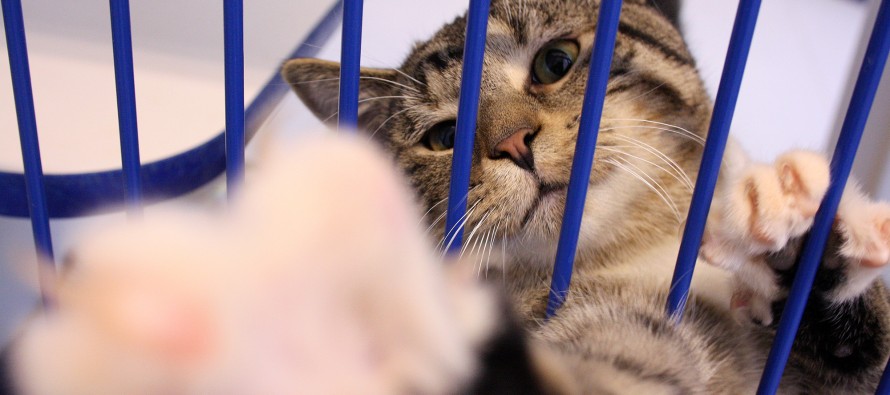Animals in extreme weather


Seven-month-old Archie reaches through the bars of his cage which he shares with his sister, Veronica at the Windsor Essex County Humane Society on Jan. 30. They have been waiting for homes for two and a half months. (PHOTO by Mandy Matthews)
By Mandy Matthews
Whether they’re from the barnyard or the backyard, animals have been suffering through the extreme weather of January 2014.
In January, new record low temperatures put Windsor’s 72-year-old record into a deep freeze when Environment Canada reported the temperature of -25 C with wind chill of -40 C making it nearly impossible to step outside. Shortly after the seventh day of the new year, Windsor Essex County Humane Society started receiving phone calls from people about animals outside for long periods of time. Amy Reaume, OSPCA officer said over 60 cases have been investigated due to citizen phone calls.
Doctor of veterinarian medicine and professor of the veterinarian technician program at St. Clair College, Chuck Fuerth, said even though humans may not want to brave the frigid weather for some exercise, it is in the animals’ nature to run and play.
“Pet owners should make sure they are only leaving their pets out for a brief period of time, perhaps be out there with them,” said Fuerth.
Bill No. 66, by-law 8156 states, “provide the necessary food, water, housing and attention as required to keep the animal in good health and free from harm.” Once a phone call is placed to the Humane Society, the OSPCA must initiate an investigation in order to insure an animal acquires an adequate shelter.
Reaume said the Humane Society’s volunteers give all of their animals, rescued and adopted, their daily exercise by interacting with toys and bringing them to the park next to the building.
Three dogs have been seized so far this year due to insufficient care. One of the three cases has been rectified by its owner; however the other two are residing in the Humane Society. Reaume, who has witnessed dogs freezing to death, said she was the one to remove the dogs from their owners. She said one of the two was lying in the snow when she arrived.
“It’s not easy going out to these houses and seeing that,” said Reaume.
According to Reaume, an adequate shelter is a fully insulated structure with an optional wind flap on the front and is an appropriate size to house the animal. If the owners are not meeting Windsor’s by-law, Reaume writes an order and gives the owner a date to comply. It is not until after the specified date, the animal is taken by the Humane Society. However, the owner is given another date to adhere to in order to obtain the animal once again, but by this time there is an undetermined seizure fee involved.
Dog owner of two different breeds, Angela West has learnt about a lot since starting her part-time job of two years at PetSmart.
“Like a lot of other people, I had no idea what I was doing,” said West. “I had a dog and I didn’t really know how to care for him, but after working there, I learned so much through my co-workers, the trainers and even the customers.”
Additionally, Fuerth said there are certain times throughout the year when the weather is cold enough to carry the threat of hypothermia or hot enough to risk heat stress.
“You have to be observant of your pet even though they are used to the cold weather,” said Fuerth. “You should be looking and checking on them if they are out longer than that brief period of five to ten minutes.”
Despite the weather, West’s one-year-old Sheltie named Duke and three-year-old American Bulldog named Feud exercise daily. West said during the record low temperatures, instead of walking her dogs for an hour straight, she limited their time outside to five to ten minutes five to six times each day.
Fuerth said much like humans, animals will experience to the same symptoms caused by extended periods of time in extreme weather. He said the best way to treat an animal who is showing signs of suffering such as shivering or panting is to gradually bring their body temperature back to normal while also massaging the extremities and indirectly applying hot or cold packages.
“Unfortunately, as a veterinarian, I’ve seen situations where a dog has been hypothermic or too cold for too long or suffered from heat exhaustion and I tell owners, if your dog is not responding within a couple of minutes, then it is best for you to get your coat on and take your pet to the vet hospital as soon as possible,” said Fuerth.
Despite the by-law, Reaume said it is not enough. Since there is no other by-law setting a limit to outside exposure towards animals, Reaume said it may not be as obvious to leave it up to the owner.
“There really is not a perfect temperature, it is more or less what kind of shelter is provided to them, whether they can get in and out of the elements,” said Reaume. “A bigger dog can handle more than a little dog, but it is always good to treat your animals as little kids.”


